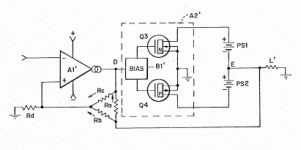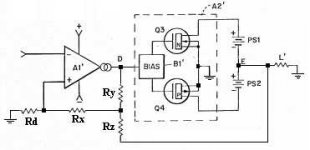jcx said:Hi mikeks,
In nested feedback you have to apply Bode’s multiloop criteria, individual loops are permitted to be “unstable” without the overall amplifier being unstable.....
I do not beleive this to be true.....allminor loops with significant local foward path gain must be individually stable....
jcx said:
There are only few hundred million counter examples to your claims that output inclusive and nested compensation can’t work
NE5532/4 compensation is described in these terms in Eschausier’s 1995 book “Frequency Compensation Techniques for Low-Power Operational Amplifiers” ....................
“A significant aid in keeping the distortion contributed
by the final stage as low as possible is provided
by the compensation scheme, which exploits
the direct connection of the Miller capacitor
at the amplifier’s output to introduce a local AC
feedback path enclosing the output stage itself.“..........
I agree totaly...but op-amp output stages are an entirely different kettle of fish from slow power BJTs....
mikeks said:
I do not believe this to be true.....all minor loops with significant local forward path gain must be individually stable....
Hi Mike, I don't think so.
At this moment, just being back from holidays (been to Crete, yes, nice weather), I've to catch up with mail and lots of forum contributions, so I haven't spend much time on finding the right articles. But I have seen a patent describing an amplifier that contained an inner loop with positive feedback (!). The overall negative feedback made the amplifier stable. A quick look revealed it to be patent 4,467,288 from James Strickland, describing the TransNova amplifier, a concept later on adopted by Hafler.
I think Janneman once told me that he has designed an amplifier with a inner positive feedback loop, but I'm not sure about that.
Steven
Attachments
Steven said:I think Janneman once told me that he has designed an amplifier with a inner positive feedback loop, but I'm not sure about that.
I remember this post also. I believe what he saw was that everything worked fine until the amp went into clipping. And I believe he said the lack of overall feedback in the clipping condition made the local instability show up. Hopefully he'll chime in on this one.
Steven said:
Hi Mike, I don't think so.
At this moment, just being back from holidays (been to Crete, yes, nice weather), I've to catch up with mail and lots of forum contributions, so I haven't spend much time on finding the right articles. But I have seen a patent describing an amplifier that contained an inner loop with positive feedback (!). The overall negative feedback made the amplifier stable. A quick look revealed it to be patent 4,467,288 from James Strickland, describing the TransNova amplifier, a concept later on adopted by Hafler.
I think Janneman once told me that he has designed an amplifier with a inner positive feedback loop, but I'm not sure about that.
Steven
I am familiar with this patent....and related Hafler designs.....
....but i think you'll find this is merely a commmon-source output stage...(rather than the usual source follower configuration)....
....with local shunt-shunt negative feedback about the output stage...
This is easily seen by merely performing a delta-star transform on Ra, Rb, and Rc....
Contrary to the patent, there is no positive feedback designed into this circuit as far i can see...
Steven said:I think Janneman once told me that he has designed an amplifier with a inner positive feedback loop, but I'm not sure about that.
Any amplifier with a finite gain is the equivalent of an amplifier with infinite gain plus a negative feedback loop.
And any amplifier with infinite gain has by definition positive feedback.
Hopefully this should settle it for the engineering types.
mikeks said:
I am familiar with this patent....and related Hafler designs.....
....but i think you'll find this is merely a commmon-source output stage...(rather than the usual source follower configuration)....
....with local shunt-shunt negative feedback about the output stage...
This is easily seen by merely performing a delta-star transform on Ra, Rb, and Rc....
Contrary to the patent, there is no positive feedback designed into this circuit as far i can see...
Yes, a common source output stage with local negative feedback by Ra. Then overall negative feedback by Rb and Rd.
But then also positive inner loop feedback by Rc around A1.
Steven
andy_c said:An integrator by itself is not stable in the BIBO sense. Yet there's lots of stable feedback systems with integrators inside the feedback loop.
I am not sure about this Andy...only a double integrator produces an unbounded output in finite time.....
On the other hand, the nominally single integration provided by Miller compensation for instance, must exclusively possess poles with negative real parts.....
This is a necessary and sufficient condition for bounded input/bounded output stability...
Steven said:
Yes, a common source output stage with local negative feedback by Ra. Then overall negative feedback by Rb and Rd.
But then also positive inner loop feedback by Rc around A1.
Steven
AAHH yes....i missed that....
Thanks Steven.....
Performing a delta-star transformation with respect to Ra, Rb, and Rc, (see figure below), gives new resistor values Rx, Ry, and Rz...
This shows that a finite amount of +ve feedback, (controlled by the ratio of Rz to Ry), is applied to gain block A1.
Setting Rz=0 for instance eliminates the +ve feedback loop.....
Note however, that since both minor and major loop feedback are derived from the same node, BIBO stability (or lack thereof) of the major loop may only be ascertained by choosing a test point that simultaneously accomodates, (or 'breaks') both minor and major feedback loops.
see section 4 here:
http://www.ece.ucdavis.edu/~hurst/papers/FullyDiffRR,CAS.pdf
Clearly then the system's overall loop transmission must be BIBO stable, notwithstanding the +ve feedback minor loop.
In other words, any propensity to local instabilty in the system must be compensated for elsewhere if the major loop is to be stable.
In this case, the local +ve feedback loop is clearly controlled by the major loop....
What happens then when when the later is momentarily disabled by anomolous operation such as clipping...?
At best you'll have excessively delayed recovery from clipping overload, at worst sufficiently prolonged 'sticking' to the supply rails to activate your DC offset protection....if such a system is employed.....
It is for these reasons that my doubts persist regarding such systems......at least in the context of nominally linear time invariant designs.....
Attachments
darkfenriz said:2 cents:
bootstrap is kind of positive feedback I think
agreed?
Applied across a unity gain foward-path....Therefore no problemo....
Some interesting observations on minor-loop instability...
http://peufeu.free.fr/audio/memory/memory-8-complete.html
In the middle of the page the vexed gentleman observes:

http://peufeu.free.fr/audio/memory/memory-8-complete.html
In the middle of the page the vexed gentleman observes:
I went on searching how to get better sound from the beta-e, by trying to cascode it. This could give the best of both : a high gain and stable dissipation. I tried several configurations, which all did nothing except oscillate with total obstination. I gave up...
mikeks said:I am not sure about this Andy...only a double integrator produces an unbounded output in finite time.....
Mike, a non-zero DC input to the integrator is the example that shows it's not BIBO stable. The discrete-time counterpart of this is the accumulator discussed on pg. 22 of Oppenheim and Schafer.
andy_c said:The discrete-time counterpart of this is the accumulator discussed on pg. 22 of Oppenheim and Schafer.
or x(t+1)=x(t)+C where C is any real number > 0.
You can certainly follow that up with either a substraction or a multiplier between (-1.0, 1.0) and make the whole system stable (ie, as t->infinite, x(t) is bounded).
It is a fairly simple example showing that you can have stability in a system where part of it isn't stable.
tlf9999 said:
..........you can have stability in a system where part of it isn't stable.
indeed you can...provided conditions for maintaining said stability are strictly defined and adhered to....
Here is an early example of positive feedback in an inner loop that is stablized by an outer NFB loop (patent # 3111630 by Wolcott, 1963):
http://patimg1.uspto.gov/.piw?Docid...ageNum=&Rtype=&SectionNum=&idkey=E44F6F40019E
Also, Hawksford output error correction, if misadjusted slightly too high on correction, can have an inner unstable loop that is held stable by the outer global NFB loop.
Don
http://patimg1.uspto.gov/.piw?Docid...ageNum=&Rtype=&SectionNum=&idkey=E44F6F40019E
Also, Hawksford output error correction, if misadjusted slightly too high on correction, can have an inner unstable loop that is held stable by the outer global NFB loop.
Don
andy_c said:
Mike, a non-zero DC input to the integrator is the example that shows it's not BIBO stable........
Hi Andy...missed this.....
......by this do you mean an integrator possesses an unbounded output at DC?
...see below for definition of BIBO stability...:
http://www.stanford.edu/class/ee214/handouts/FB.pdf
mikeks said:...see below for definition of BIBO stability...:
Yes, the poles must be in the open left-half plane (Re(pole) < 0). But for an ideal integrator, Re(pole) = 0, so the integrator itself is not BIBO stable. That's all I was saying.
Edit: This was in the reference you posted. It says page 11 of 34 at the bottom of the page.
Yes.......i was thinking in terms of a non-ideal implementation such as exists in an audio amp.....
....for which integration can only be said to occur within a finite band of frequencies....
Then again.....even if ideality were assumed, (with the pole at the origin implying an unbounded output for a bounded DC input), we find that a shunt-shunt integrator of the form used in generic amps. possesses no feedback at DC....making BIBO instability academic.
....for which integration can only be said to occur within a finite band of frequencies....
Then again.....even if ideality were assumed, (with the pole at the origin implying an unbounded output for a bounded DC input), we find that a shunt-shunt integrator of the form used in generic amps. possesses no feedback at DC....making BIBO instability academic.
- Status
- This old topic is closed. If you want to reopen this topic, contact a moderator using the "Report Post" button.
- Home
- Amplifiers
- Solid State
- how many ways to stablise?

